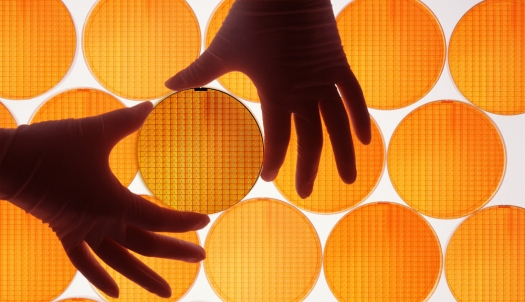US team find new way to transfer 2D MoS2 films

Technique uses water, a tissue and a pair of tweezers
Researchers from North Carolina State University have developed a new way to transfer one atom thick MoS2 semiconductor films onto arbitrary substrates. The technique, decribed in the journal ACS Nano is claimed to be much faster than existing methods and can perfectly transfer the atomic scale thin films from one substrate to others, without causing any cracks.
"The ultimate goal is to use these atomic-layer semiconducting thin films to create devices that are extremely flexible, but to do that we need to transfer the thin films from the substrate we used to make it to a flexible substrate," says Linyou Cao, an assistant professor of materials science and engineering at NC State, who is senior author of a paper on the new transfer technique.
"You can't make the thin film on a flexible substrate because flexible substrates can't withstand the high temperatures you need to make the thin film."
The researchers needed to find a way to move MoS2 films up to 5 centimeters in diameter."To put that challenge in perspective, an atom-thick thin film that is 5 cm wide is equivalent to a piece of paper that is as wide as a large city," Cao said. "Our goal is to transfer that big, thin paper from one city to another without causing any damage or wrinkles."
Existing techniques for transferring such thin films from a substrate rely on chemical etching, but the chemicals involved in that process can damage or contaminate the film. Cao's team has developed a technique that takes advantage of the MoS2's physical properties to transfer the thin film using only room-temperature water, a tissue and a pair of tweezers.
MoS2 is hydrophobic - it repels water. But the sapphire substrate the thin film is grown on is hydrophilic - it attracts water. Cao's new transfer technique works by applying a drop of water to the thin film and then poking the edge of the film with tweezers or a scalpel so that the water can begin to penetrate between the MoS22 and the sapphire. Once it has begun to penetrate, the water pushes into the gap, floating the thin film on top. The researchers use a tissue to soak up the water and then lift the thin film with tweezers and place it on a flexible substrate. The whole process takes a couple of minutes. Chemical etching takes hours.
"The water breaks the adhesion between the substrate and the thin film - but it's important to remove the water before moving the film," Cao says. "Otherwise, capillary action would case the film to buckle or fold when you pick it up.
"This new transfer technique gets us one step closer to using MoS2 to create flexible computers," Cao adds. "We are currently in the process of developing devices that use this technology."
The research was funded by the US Army Research Office under grant number W911NF-13-1-0201 and the National Science Foundation under grant number DMR-1352028.































